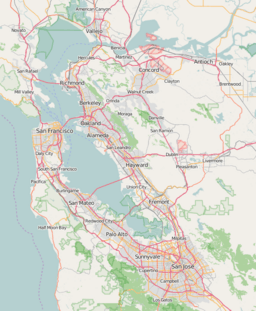Seal Slough facts for kids
Quick facts for kids Seal Slough |
|
|---|---|
| Location | San Mateo County, California |
| Coordinates | 37°34′15″N 122°17′39″W / 37.5707687°N 122.2941354°W |
| Type | Slough (hydrology) |
| Part of | San Francisco Bay |
| River sources | Borel Creek, Leslie Creek, Laurel Creek |
Seal Slough is a winding, narrow water channel located in San Mateo and Foster City, California. It's a special type of waterway called a tidal slough, which means its water levels change with the ocean tides. This slough flows through a tidal marsh, which is a wet, grassy area often found near the coast.
In recent years, people have been working on a special project to make Seal Slough a better home for plants and animals. This is called a wetland restoration project. It helps improve the natural habitat of the area. Since at least 1954, the slough has also been dredged. This means that mud and sand are removed from the bottom to make it deeper.
Back in 1935, the city of San Mateo built its first sewage treatment plant. The treated water from this plant was sent into Seal Slough. Today, the marsh around Seal Slough is a very active and important brackish wetland. "Brackish" means the water is a mix of fresh water and salty ocean water. The main plant growing here is called cordgrass.
Seal Slough is home to many important wildlife species. One special bird that lives here is the California clapper rail. This bird is an endangered species, meaning there are very few of them left in the world. A special gate, called a tide gate, helps control the flow of water from San Francisco Bay into the Marina Lagoon. This helps keep the water moving, which is important to prevent too many midge insects from growing in the area.
Where Seal Slough Flows
Seal Slough connects with San Francisco Bay on the eastern side of San Mateo. This is about halfway between Coyote Point and the San Mateo Bridge. Near where the slough meets the bay, there's a marshy area and a large section of bay mud. This mud extends about 700 meters north into San Francisco Bay.
Close to the mouth of the slough, you'll find the city of San Mateo's Wastewater Treatment Plant and Bayside School. The slough itself is very winding and twisty as it flows eastward. As it continues, homes are built very close to its southern banks. In this middle part, it also flows near Parkside School. Further east, it passes Lakeshore School before going under Hillsdale Boulevard and entering Foster City.
The Amazing Ecology of Seal Slough
Much of what we know about Seal Slough comes from a study done in 1980. This study looked at how a new bridge across the slough might affect the environment. The most important natural area along Seal Slough is its tidal mouth. Here, scientists have found three main plant community zones.
The lowest zone is made up of mudflats or areas where cordgrass (distichlis sp.) is the main plant. The middle zone is known for a plant called pickleweed (Salicornia sp.). The upper zone, which has been changed the most by human activity, has salt grass (Distichlis spicata) and other halophytes. Halophytes are plants that can grow well in salty soil. The pickleweed plants grow mostly on the north banks of Seal Slough.
Cordgrass and pickleweed habitats are some of the most productive places in California. They create a lot of organic material each year. These plants also provide detritus (dead plant material) to the nearby mudflats. This detritus is the basic food source for many creatures in the estuarine food chains. An estuary is where a river meets the sea.
Cordgrass is also a source of food and cover for many waterfowl. This includes the endangered California clapper rail, which lives in Seal Slough. Other birds found in this rich wetland include killdeer, mallards, and the snowy egret. The mudflats of Seal Slough are also important feeding areas for many fishes during high tides. These include topsmelt, anchovy, bat ray, leopard shark, spiny dogfish, striped bass, and longjaw mudsucker.
Images for kids




